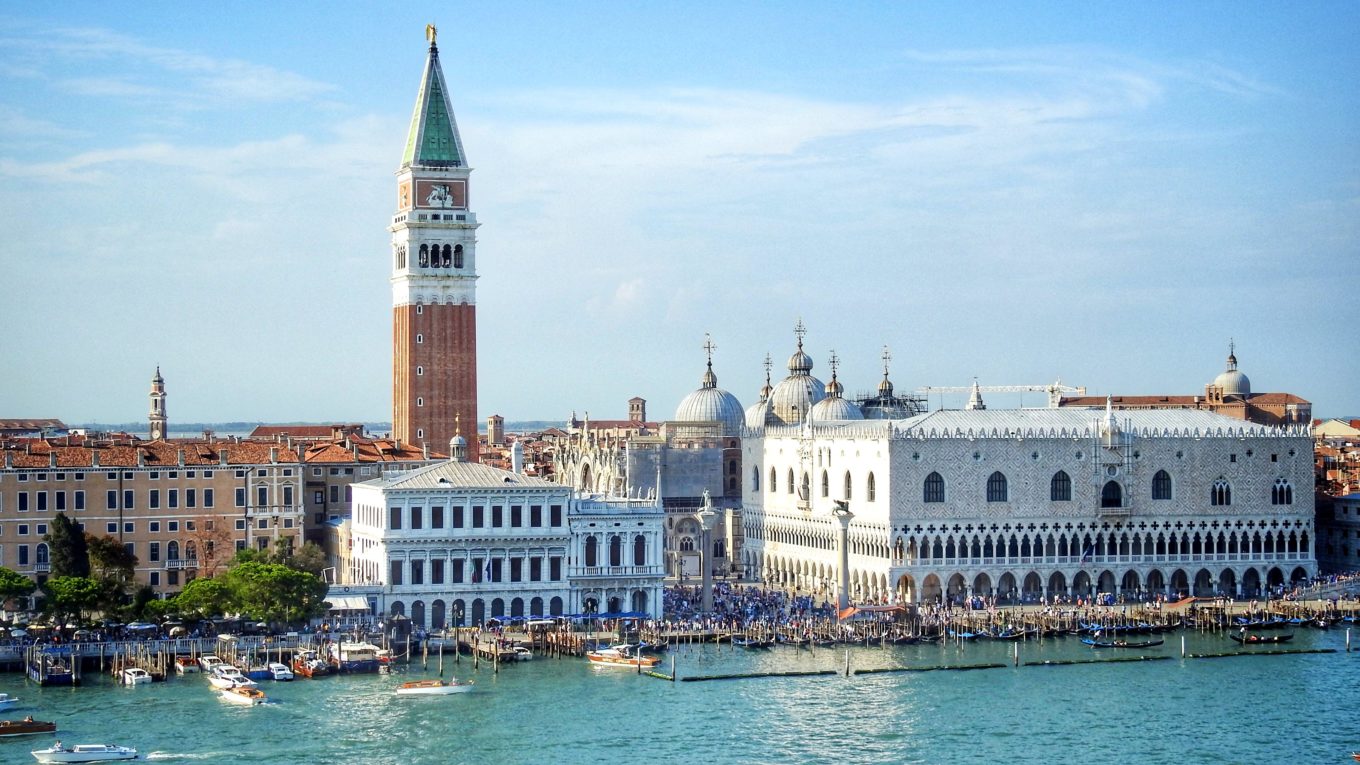Venetian Cities and Venetian Architecture
Note: this article is about the architecture of the Republic of Venice, if you’re looking for information on the city of Venice, check out our article, “Architecture of Venice, Italy“
The Republic of Venice was one of the greatest maritime powers of the Middle Ages. They controlled a vast territory that spread from their capital in Italy across the sea to the shores of modern-day Croatia, Montenegro, Slovenia, and Greece. Although most people only think of Venice when they picture Venetian Architecture, many Venetian-style buildings can be found throughout their former empire. This article will take a deeper look into the other cities of the Republic of Venice, and highlight Venetian Architecture from throughout the Mediterranean.
Table of Contents:
- Brief History of the Republic of Venice
- Venetian Architecture Characteristics
- Venetian Architecture in Italy
- Venetian Architecture in Croatia
- Venetian Architecture in Greece
- Venetian Architecture in Slovenia
- Venetian Architecture in Montenegro
- Venetian Architecture in Cyprus
- Venetian Walls, Castles, and Fortifications
Brief History of the Republic of Venice
Shortly after the fall of the Western Roman Empire in the 5th century CE, groups of Germanic Tribes were raiding and looting large swaths of Northern Italy. Each time they were attacked, people would flee into the Venetian Lagoon and seek shelter on some of the islands. They started a small and humble settlement that would eventually grow into the city of Venice. Venice quickly grew economically and politically, and by the end of the 7th century, the Republic of Venice was founded.
The Venetians were masters of the sea and they became extremely wealthy thanks to maritime trade. As the Venetian Military grew more powerful, the Republic gained control of territories throughout the Mediterranean. At its peak in the Late Middle Ages, the Republic of Venice controlled its Stato da Màr or Domains of the Sea and its Domini di Terraferma or Domains of the Mainland. On the Italian Mainland, the cities of Padua, Vicenza, Verona, Treviso, and Bergamo were all controlled by the Venetian Empire at various points in history. And across the Adriatic and Mediterranean, the Venetians controlled various cities such as Split, Rovinj, Zadar, Kotor, Heraklion, and Corfu.
The final century of the Republic of Venice was known as a time of opulence and grandeur, even though the power of Venice was in a state of rapid decline. While Venice hosted great carnivals back in the capital, it suffered several defeats at the hands of the Ottoman Empire during the Venetian-Ottoman Wars. Venetian trade superiority was also a thing of the past as most of Europe’s trade shifted away from the Mediterranean and to the Americas by the 16th and 17th centuries. The Venetian Republic was eventually disbanded in 1797, during the Napoleonic Wars. Venice was then controlled by a few other states, including the Habsburg Empire, before joining the Kingdom of Italy in 1866.
Venetian Architecture Characteristics
The Venetian Lion
Photo by Dennis Jarvis from flickr
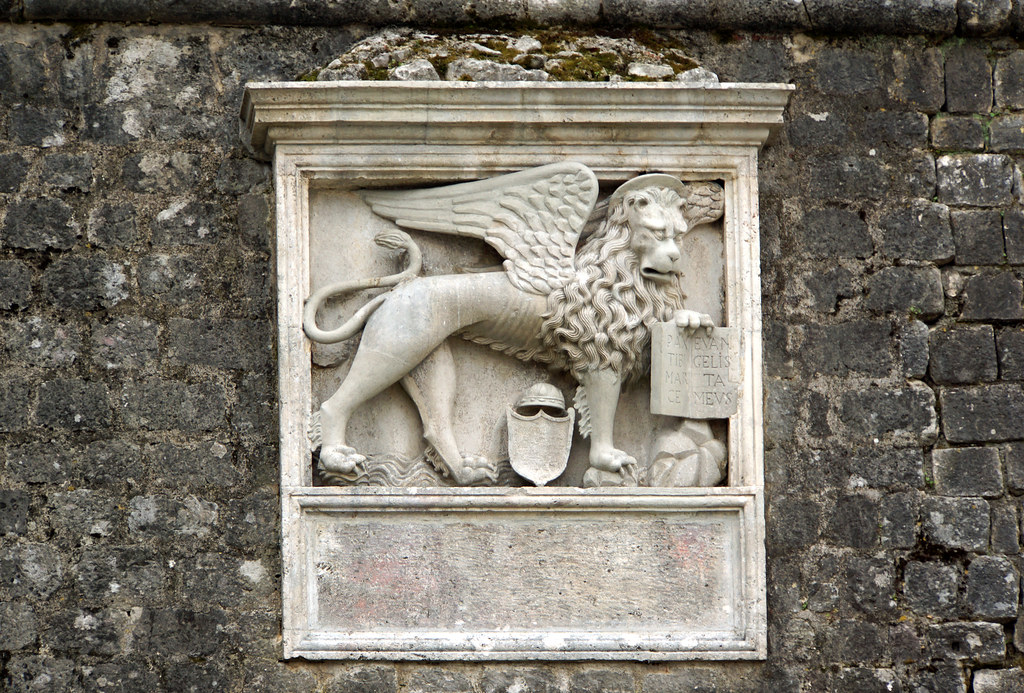
The Lion of Venice was the symbol of the Republic of Venice, and it appears throughout their formal crests and banners. The lion is always depicted with wings and is often holding a book or a sword. This symbol is found throughout the Architecture of the Venetian Republic, often at the tops of columns and within city walls and gates. The Venetian Lion in the image above is positioned just outside the Sea Gate within the fortified walls of Kotor in Montenegro.
Venetian Style Bell Towers
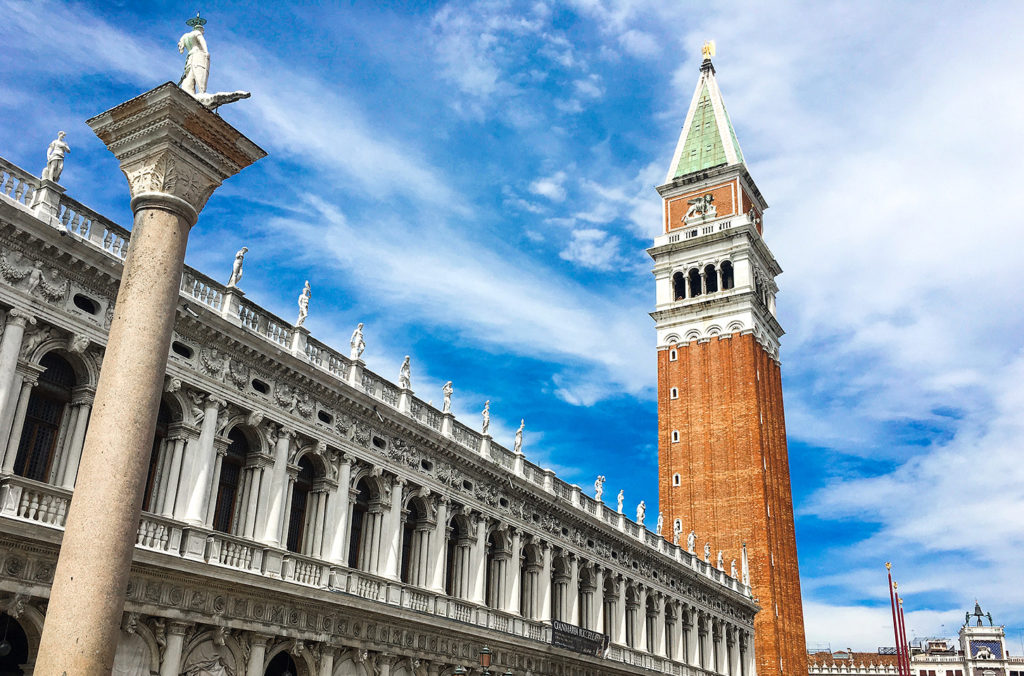
Just about every major Venetian City had a cathedral featuring a bell tower with thin proportions and a steeply pitched roof. These towers are apparent everywhere, within the city skylines of Verona, Rovinj, Burano, Venice, and many others. St. Mark’s Campanile (depicted above) is the bell tower of St. Mark’s Basilica in Venice. The foundations of the tower were built in the 10th century, but it wasn’t until the early 1500s that the top belfry and spire were added. The top of St. Marks Campanile is a great example of the many works of Renaissance Architecture within the city of Venice.
Large Fortification Networks
Photo by Neil Thompson from flickr
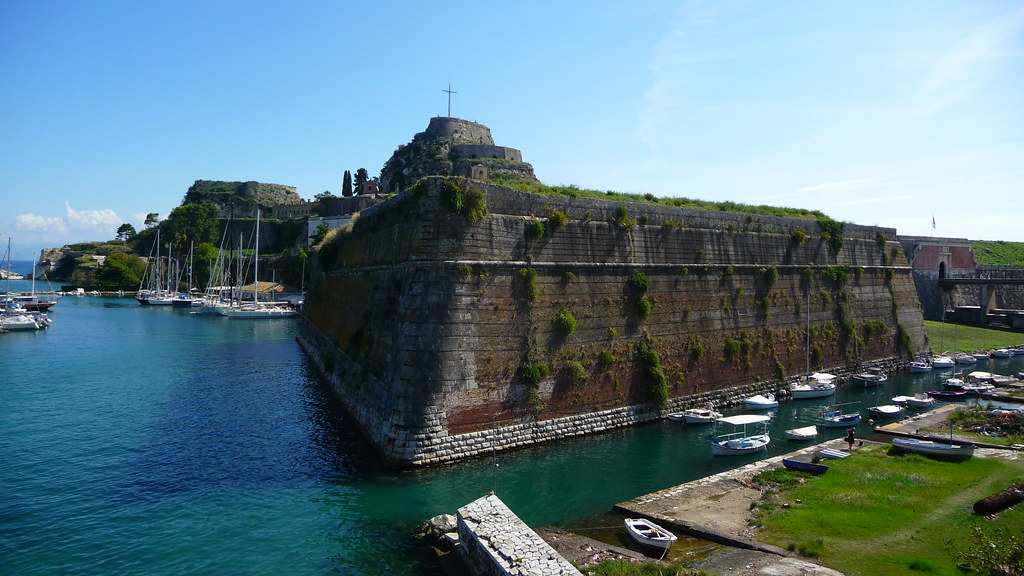
Another element that you see in nearly all Venetian Cities is extensive fortification systems. Venice reached the peak of its power after the adoption of Gunpowder at a time when Star Forts and low earth-packed walls were commonplace in most European cities. The Old Venetian Fortress is one of two massive forts built within the city of Corfu in Greece. Many other Venetian Cities have similar fortifications, such as Heraklion, Chania, and Kotor. A few of these fortifications are combined to form UNESCO World Heritage Site known as the “Venetian Works of Defence between the 16th and 17th Centuries.”
Canals
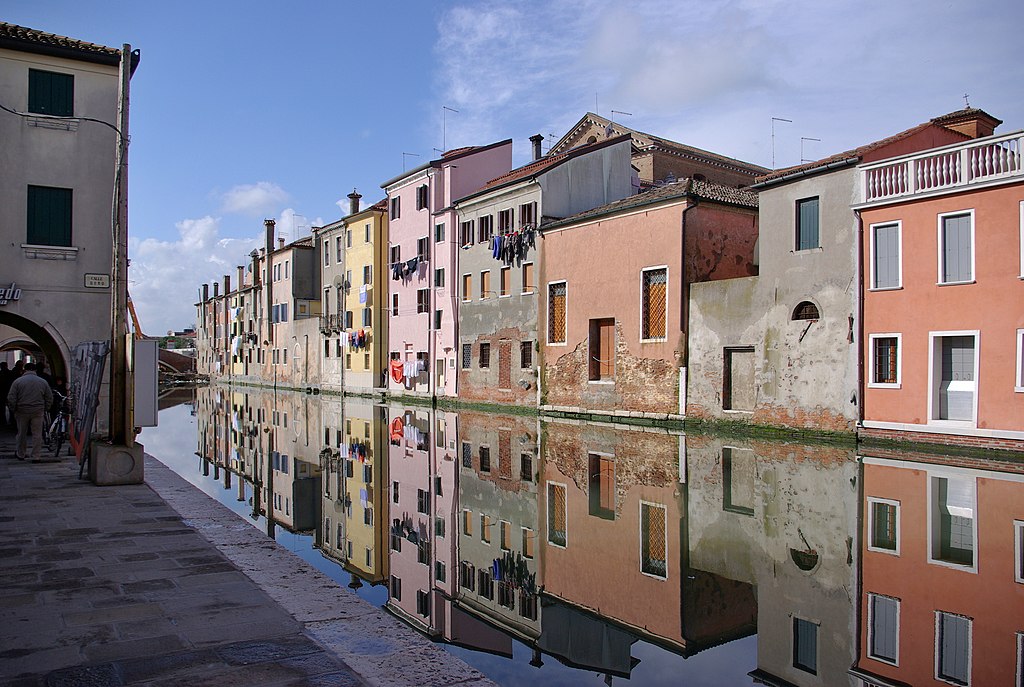
The Canals of Venice are by far the most famous of any Venetian City, but there are still several other cities that utilize canals in a major way. Particularly for cities within the Venetian Lagoon, such as Burano and Chioggia these canals are integral to the overall layout of the city. On the Italian mainland, cities like Treviso also utilize canals in addition to more traditional roadways. The above image shows a canal in Chioggia, which is located within the Venetian Lagoon, just 18 miles (30 km) south of Venice.
Venetian Architecture in Italy
Venice was the capital and largest city of the Venetian Republic. But the surrounding lagoon is home to several other Venetian Cities, that while much smaller than Venice, were still important parts of the republic’s trade network. As Venice expanded deeper into mainland Italy, it gained control of several large urban areas such as Treviso, Padua, and Vicenza. Venice referred to its land holdings within Italy as the Domini di Terraferma or Domains of the Mainland, and this territory loosely correlates to the modern-day Veneto Region of Italy.
1. Venice, Veneto, Italy

Venice was inhabited as early as the 6th century by settlers fleeing war-ravaged parts of Northern Italy. The city was incorporated into the Eastern Roman or Byzantine Empire starting in 553 which resulted in a strong Byzantine Influence amongst early works of Venetian Architecture. By the end of the 7th Century, the Republic of Venice was established, and the city became the capital of a prosperous maritime power. Venice contains architecture spanning nearly every age, from early Byzantine and Romanesque Churches to works of Venetian Gothic Architecture, to the Venetian Renaissance, and even the Baroque and Rococo movements of the 18th century,

Venice originated as a group of over 100 islands. These islands were not really suitable for buildings, due to the lack of usable land and the fact that the soil itself was just soft mud. Some of the earliest works of Venetian Architecture didn’t last more than a few years because they were sinking down into the mud below. To combat this problem, Venetian Engineers created a system for driving wooden piles deep into the mud and topping them with stone pavers. Using this method, they were able to create new permanent land that was perfectly suited for supporting structures.
2. Padua, Veneto, Italy
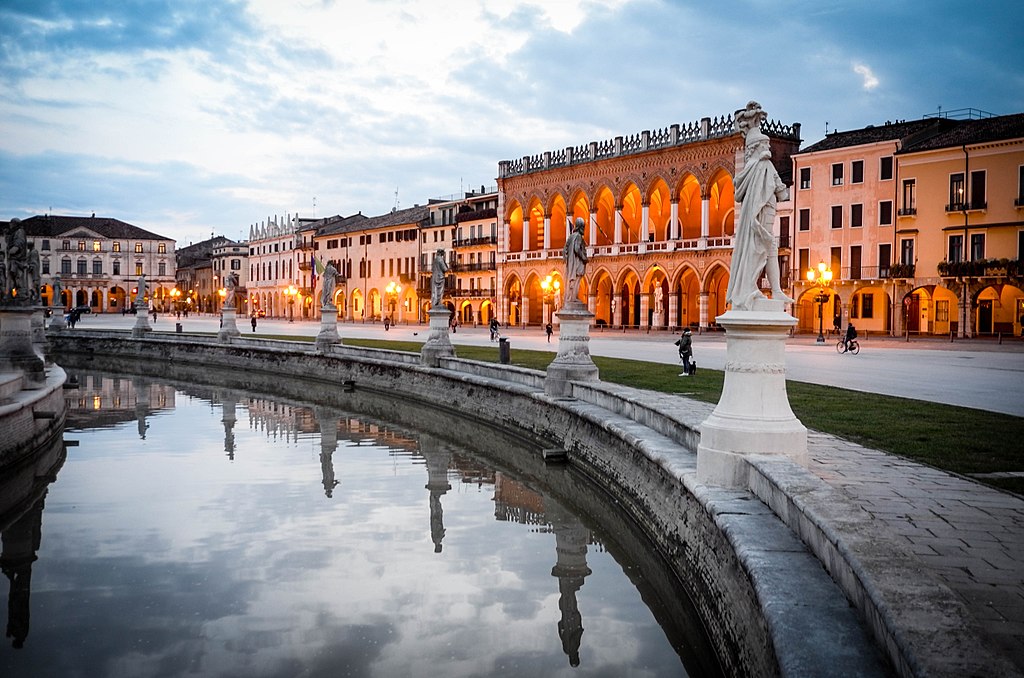
Padua is one of the largest cities in the Veneto Region, and it was controlled by the Republic of Venice starting in 1405. The Venetians controlled the city for nearly 400 years, and they left behind a lasting impact that gives Padua much of its charm. The Prato della Valle is a large elliptical square within the city that was built during the 1700s. Although the canal within the center of the square is completely decorative, it still echoes back to the canals of the Venetian Capital. The Loggia Amulea is a main building within the square, which dates from the mid-19th century. Although built after the days of the Venetian Republic, the architect still used a distinct Neo-Venetian Gothic Style for the design.
3. Vicenza, Veneto, Italy
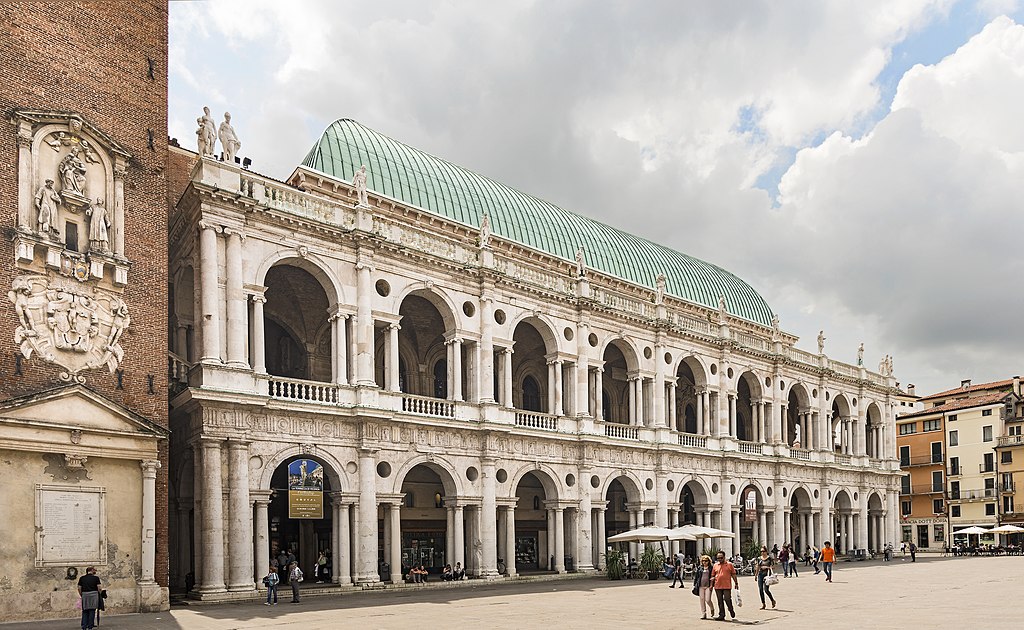
Located about 43 miles (70 km) inland from the Venetian Lagoon, the city of Vicenza was one of the most important settlements in the Veneto Region. Like Padua, Vicenza came under Venetian Control in the early 15th Century, in the year 1404. Quite possibly the most famous building in the entire city is the Palladian Basilica located within Piazza dei Signori. Although the main hall dates from the Gothic Age, the entire exterior dates to the time of the Venetian Republic. It was designed by one of the most important architects of the Renaissance, Andrea Palladio. Work began in 1549, and it’s regarded as one of Palladio’s greatest buildings.
4. Verona, Veneto, Italy
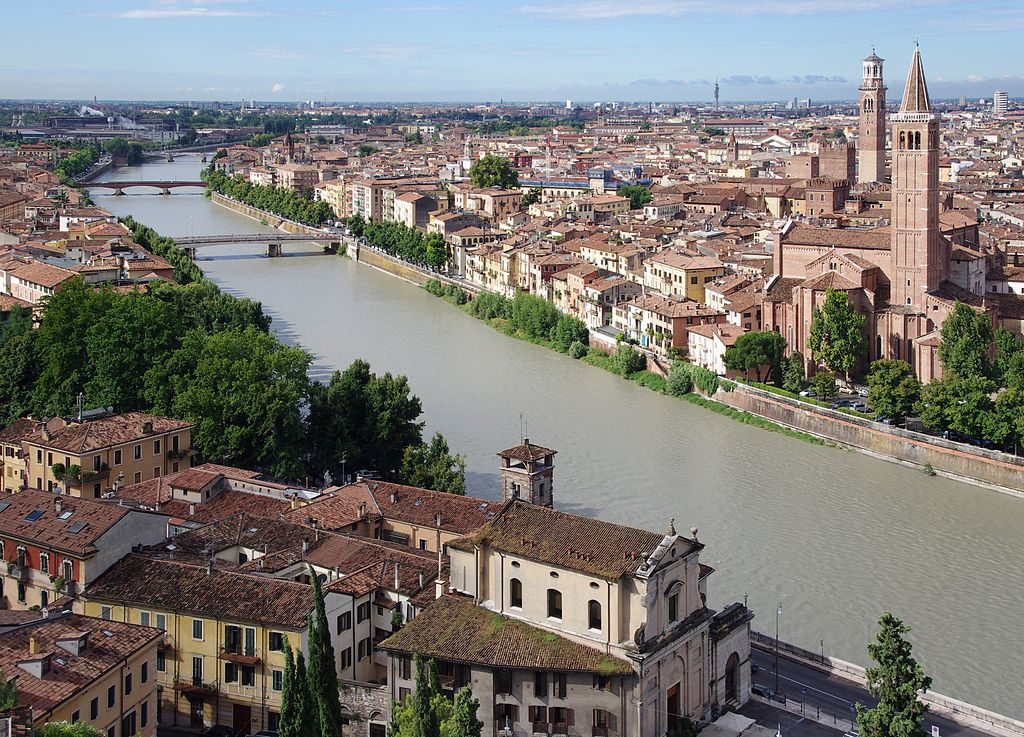
Although Verona is famous for its ancient buildings, including the Roman Amphitheater of Verona, it is also a great destination for Venetian Architecture. The city was controlled by the Republic of Venice starting in the early 1400s as Venice was pushing deeper into the Italian mainland. The Basilica di Santa Anastasia, one of the main churches within Verona, can be seen at the river’s edge in the image above. The bell tower was modified over time, and it greatly resembles the other bell towers found throughout the Venetian Republic. The Venetians also created a massive fortification network enclosing Verona with several miles of walls and ramparts.
5. Chioggia, Veneto, Italy

Chioggia is a small city in the Venetian Lagoon that bears a striking resemblance to Venice. The city follows the same mold, man-made landmasses on top of wooden piles, that are separated by canals. Chioggia was part of the Republic of Venice for longer than nearly every other city on this list, and the city shares the same culture, cuisine, and architecture as its much larger neighbor. Today, Chioggia is a small town of about 50,000, and its main industry is tourism, as travelers venture out to the city as a way to experience Venetian Culture, without all of the Venetian crowds.
6. Palmanova, Friuli Venezia Giulia, Italy
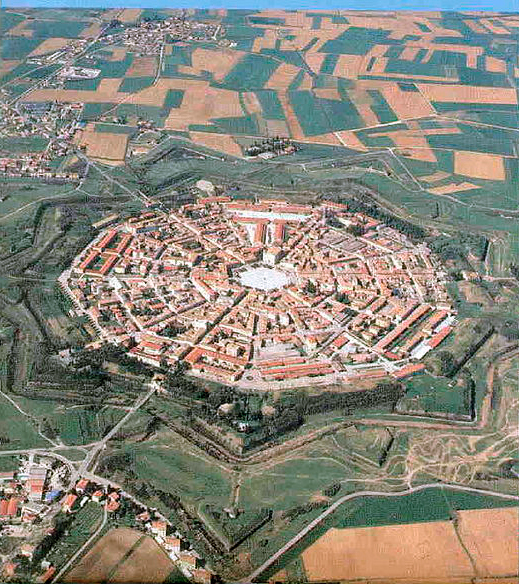
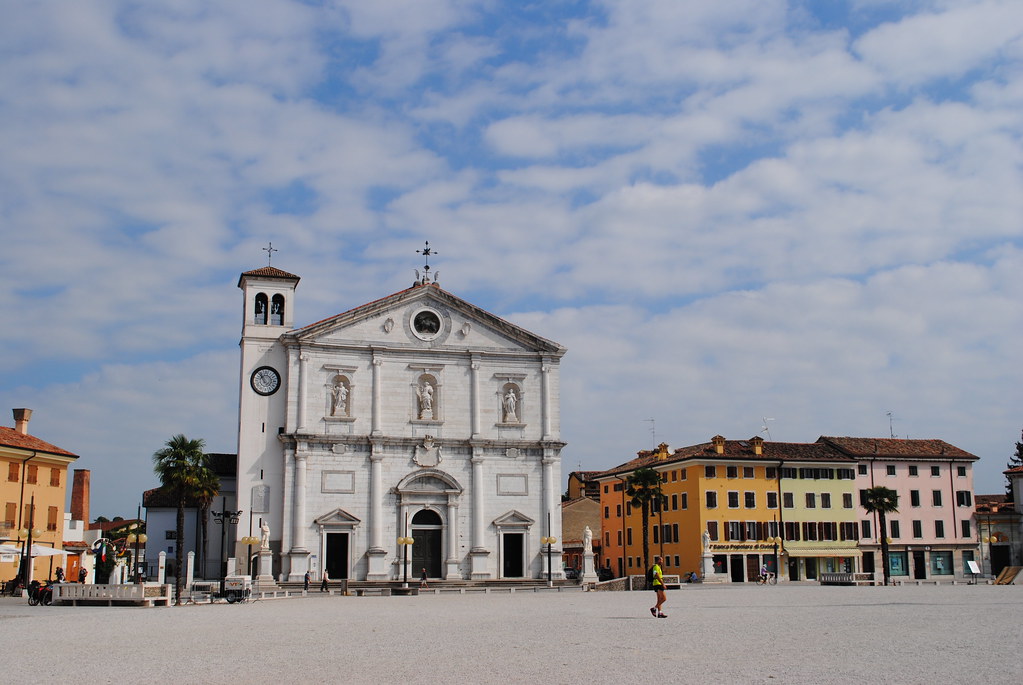
Palmanova is possibly the greatest example of a pre-planned fortified city anywhere in Europe. These fortified cities were popular after the age of gunpowder and were an important part of the defensive networks of many large nations. They served a similar purpose to many medieval castles and fortified towns. The basic idea dates all the way back to the Renaissance in the mid-1400s when the proposed city of Sforzinda was drawn up by a Florentine artist known as Filarete. Palmanova was completed in the year 1593 and today is part of a UNESCO World Heritage Site along with several other works of Venetian Defensive Fortifications.
7. Burano, Veneto, Italy
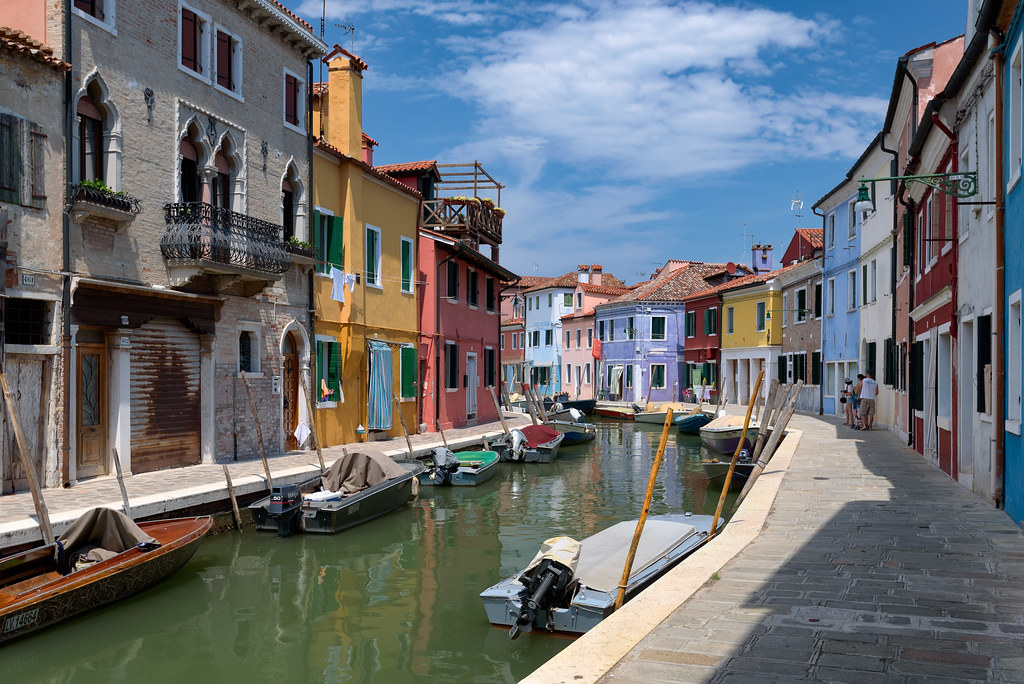

A city known for its pastel colored facades, Burano is another Venice-like city located within the Venetian Lagoon. Like Venice and Chioggia, it utilizes a system of canals rather than traditional roads. Most transportation within the city is either done on foot or by boat. Burano is also notorious for its leaning tower. Although not nearly as famous as the one in Pisa, the leaning tower of Burano is a focal point within the city. The tower leans thanks to the soft shifting mud located beneath its foundation, which is a problem for most of the cities within the Venetian Lagoon.
8. Treviso, Veneto, Italy

Treviso agreed to join the Republic of Venice in the year 1339, making it one of the earliest mainland cities to do so. The city benefited greatly from joining with the Venetians, who protected Treviso and also invested in the city’s infrastructure. The Gate of San Tomaso (depicted above) is the centerpiece of the massive Venetian fortification network that surrounds the city. Not only was the gate meant to be defensive, but it was also supposed to show off the wealth and power of the republic. Anyone who entered Treviso had to pass beneath the mighty Venetian Lion over the main gate.
9. Bergamo, Lombardy, Italy
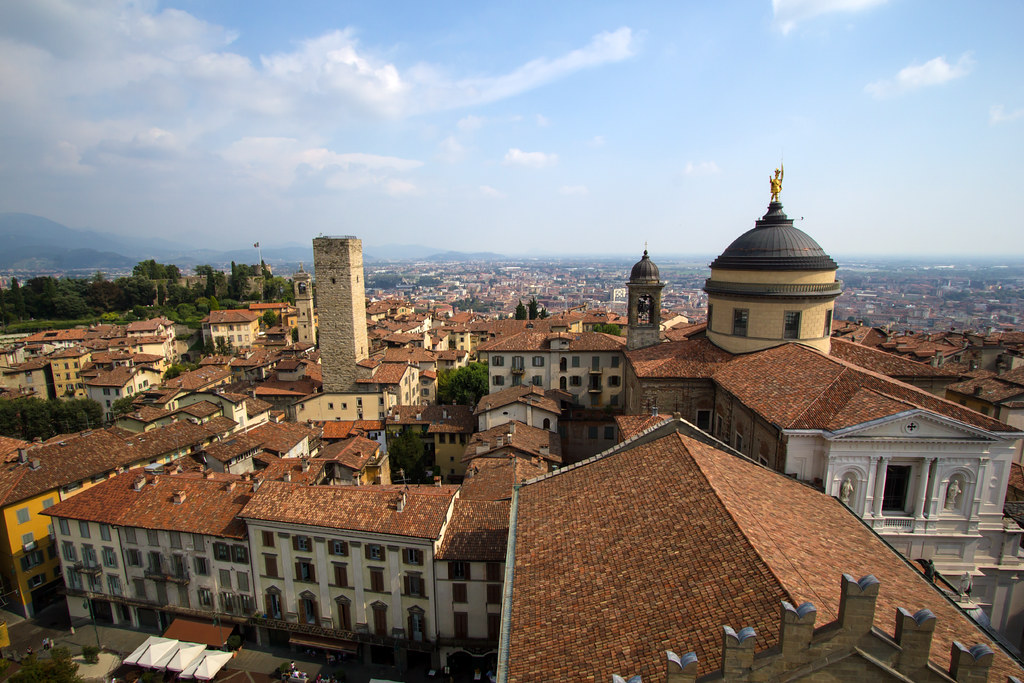
Bergamo is a city in northern Italy that is located just 30 miles (50 km) away from Milan. It’s not surprising that it was part of the Duchy of Milan for a long time before it was eventually absorbed into the Republic of Venice in 1428. The Venetians improved the city’s fortifications, following a similar methodology to many other nearby towns and cities. Bergamo is famously the final resting place of one of Venice’s greatest generals, Bartolomeo Colleoni. Colleoni died in 1475, and his mausoleum was built as part of the Basilica of Santa Maria Maggiore. Today, this mausoleum is one of Bergamo’s most important buildings, and it’s one of the greatest examples of Venetian Renaissance Architecture anywhere in Italy.
Venetian Architecture in Croatia
Croatia contains one of the highest concentrations of Venetian Cities found anywhere outside of Italy. The regions of Istria and Dalmatia are two coastal areas that were once an important part of Venice’s maritime territories. These regions helped the Venetians control nearly all of the trade going through the Adriatic, and helped spread the influence of Venice southward to the rest of the Balkans and Greece. Today, Croatia is a proud and independent nation, but it still holds on to many aspects of Venetian Culture thanks to the long-standing influence of the Republic of Venice.
1. Rovinj, Istria, Croatia

Rovinj is a city along the Istrian Peninsula in northern Croatia. It’s located about 72 miles (116 km) across the Adriatic Sea from Venice, and it came under Venetian control starting in 1283. The skyline is dominated by the Venetian-style bell tower attached to the Church of St. Euphemia. The church sits atop the highest point in the city, and it was built in the Baroque Style starting in 1725.

In addition to the city’s main cathedral, several important buildings within Rovinj were built by the Venetians. There is a Renaissance clock tower located within the main square of the city, overlooking the harbor. There are also several fortified walls that were built by the Venetians along the seaward-facing edge of the city. Although not as massive as Venetian Fortifications in other cities, Rovinj’s walls show how the Republic of Venice was very serious about protecting its borders.
2. Zadar, Dalmatia, Croatia
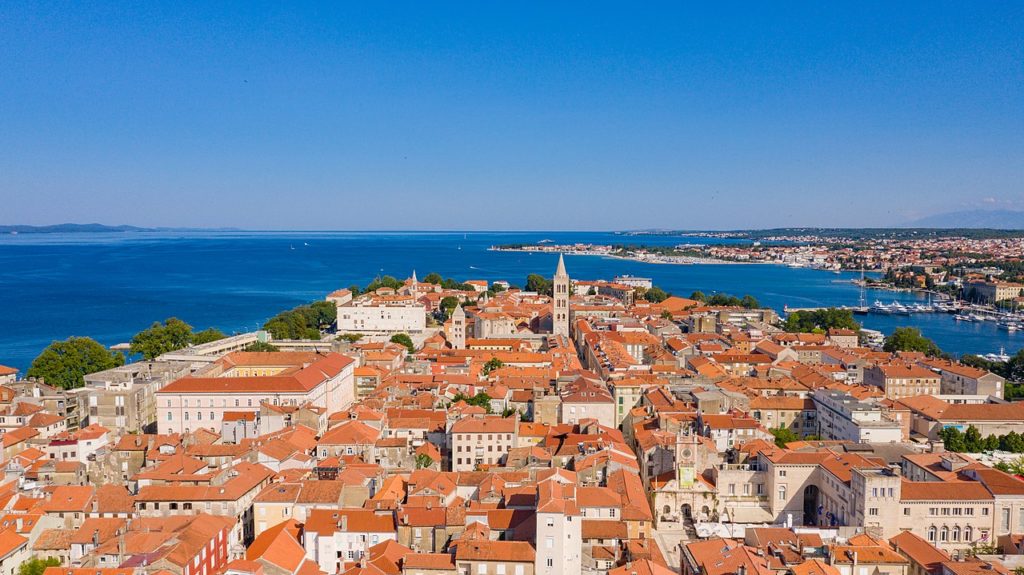
Located within the coastal region of Dalmatia, Zadar is another city that was once an important port within Venice’s Maritime Republic. Zadar has a similar layout when compared to many of the other cities on this list. The densely packed city center sits on a peninsula right at the water edge, and it was once separated from the mainland by a fortified wall. Zadar’s historic center remains remarkably well preserved, making it very popular with tourists. Today, Zadar is one of the larger cities within Croatia, and it has expanded onto the mainland to incorporate a territory of 10 square miles (25 km2).
Like Architecture of Cities? Sign up for our mailing list to get updates on our latest articles and other information related to Architectural History.
3. Šibenik, Dalmatia, Croatia

Located just an hour’s drive south of Zadar, Šibenik is another seaside town within Croatia’s Dalmatian Coast. It was incorporated into the Venetian Republic starting in the year 1412, after a lengthy war with Venice. Under Venetian rule, Šibenik prospered and grew into an important trading port. Šibenik Cathedral is the city’s most important site, and it was built during the period of Venetian Control. Construction started on the church in 1431 and was mostly complete by 1535. Šibenik Cathedral is a great example of Venetian Renaissance Architecture, and that’s part of why it was recognized as a UNESCO World Heritage Site in the year 2000.
4. Trogir, Dalmatia, Croatia

Trogir is a Dalmatian City that’s located on a fortified island, and it’s separated from mainland Croatia by a canal. The entire historic center of Trogir is UNESCO protected. Thanks to strict building regulations, the city looks almost the same today as it did during the times of the Venetian Republic. Although it’s one of the smaller Venetian Cities on this list, Trogir is still known for its several important architectural monuments. There is a Venetian Castle on the west side of the island, and the main square on the east side of the island contains several works of Venetian Architecture, including a Gothic Palace and a Renaissance-style Loggia.
5. Poreč, Istria, Croatia

Just like Rovinj, Poreč is another important city located within the Croatian Region of Istria. Poreč is located on its own peninsula, which makes the city and its harbor easy to defend from land-based attacks. Known as Parenzo in Venetian times, Poreč was one of the first overseas holdings for Venice, being added to the republic in 1267. Today, Poreč is well known for its two major churches, the Church of Our Lady of the Angels and the Euphrasian Basilica. The Basilica is a great example of Byzantine Architecture from when most of Croatia was controlled by the Byzantine Empire.
6. Split, Dalmatia, Croatia
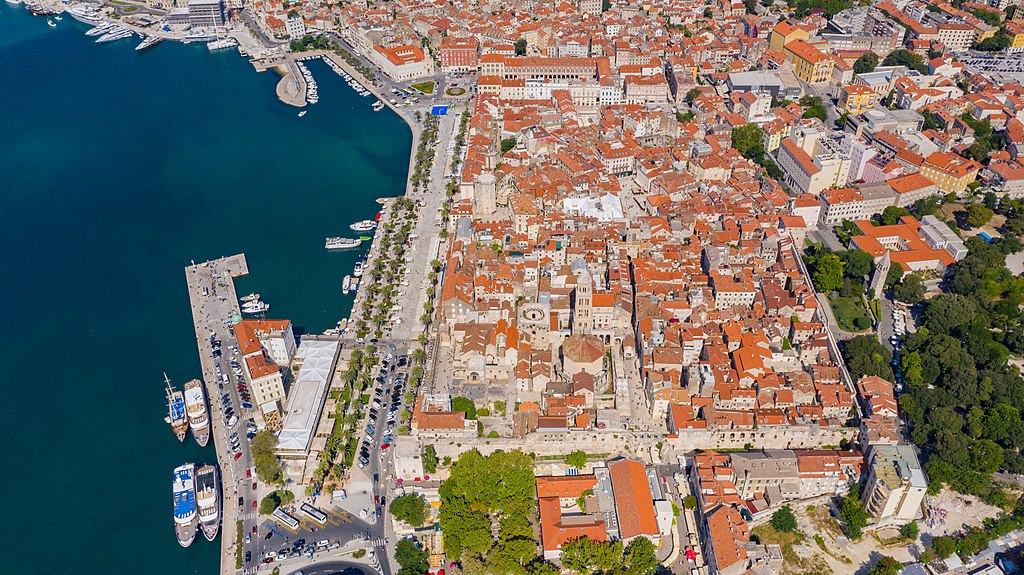
Split is the second-largest city in Croatia and the largest city within the region of Dalmatia. It was founded in 305 CE, not as a city, but actually as a fortified palace for the Roman Emperor Diocletian. After the fall of the Roman Empire, local populations moved into the palace and took full advantage of its protective stone walls. Split grew in size significantly during the Middle Ages and spread far outward from the original palace footprint. The city became part of the Republic of Venice in 1420, and the Venetians built many works of architecture, including several fortified walls and towers, as well as the town hall, which faces the Pjaca, or “People’s Square.”
Venetian Architecture in Greece
Greece contains several former Venetian Cities, all of which are filled with great examples of Venetian Architecture. Although Venice’s territories in Greece were constantly under threat from the expanding Ottoman Empire, the Republic of Venice still managed to control many important areas during the 13th-18th centuries. Portions of both the Greek Mainland and the Greek Islands were controlled by Venice, with the islands of Corfu and Crete containing some of the most important Venetian Cities. Greece also contains some of the most extensive Venetian Fortifications, thanks to the turbulent political situation between the Venetians and the Ottomans.
1. Corfu, Island of Corfu, Greece
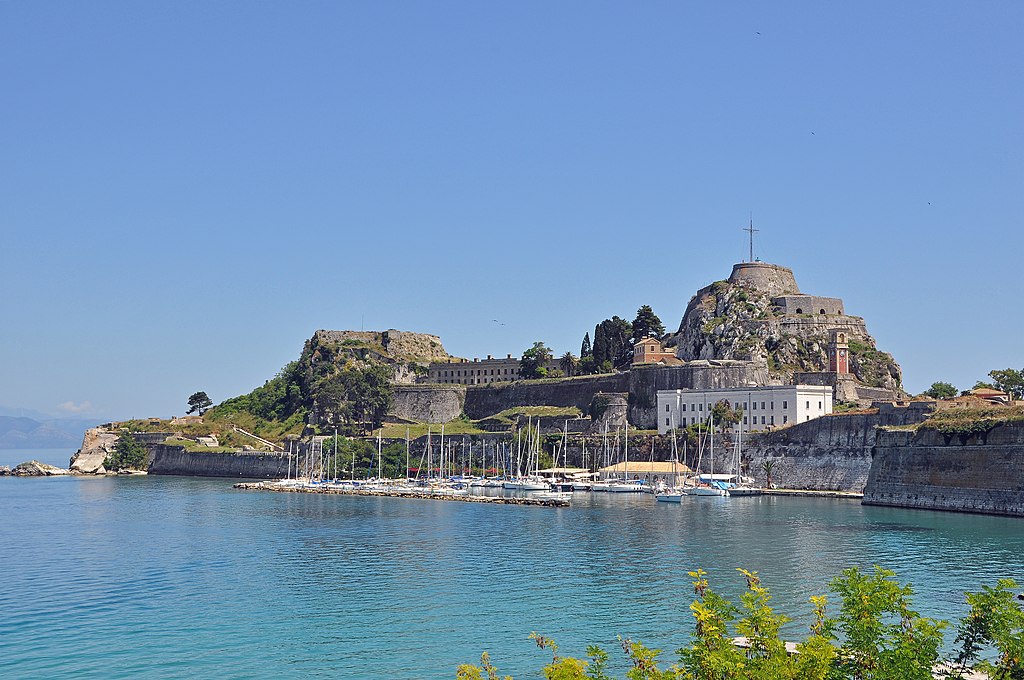
Corfu is a Greek Island located west of the Greek Mainland, where the Adriatic and the Mediterranean Seas meet. The largest city on the island is also called Corfu and was founded as far back as 1300 BCE. It was a major city-state in the Greek Hellenistic world, and it continued to be important in the Roman and Byzantine Empires. The Venetian Republic seized control of Corfu in 1386, and it controlled the island for centuries until the collapse of the republic in 1797.
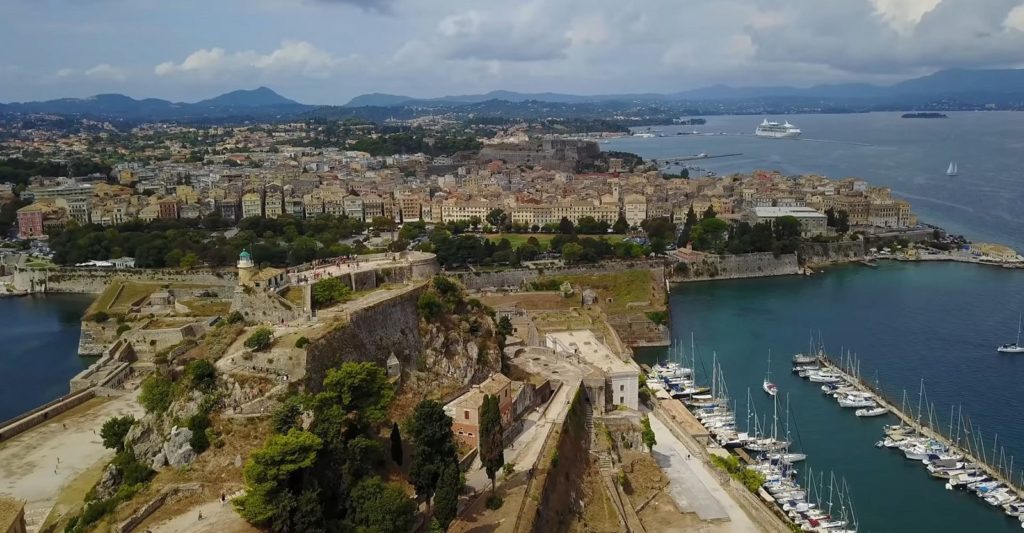
Because the Venetians controlled the city for so long, they were able to make major updates to Corfu’s infrastructure. To the east of the city center, the Old Venetian Fortress (depicted above) sits on a peninsula jutting out into the harbor. This older fort protected the city from attacks by sea, while the New Venetian Fortress was located on the mainland of Corfu and protected the western side of the city from attacks via land.
2. Nafplio, Peloponnese, Greece

Located within the Peloponnese region of modern-day Greece, Nafplio is a coastal city that was controlled by Venice starting in 1388. Palamidi Castle was built by the Republic of Venice during the late 17th century, and it protects the city along with several other forts. Nafplio was an important outpost of the frontier of the Venetian Republic, pressed up against the border with the Ottoman Empire. The city was besieged twice by the Ottomans, and it changed hands between the Venetians and Ottomans on several occasions.
3. Heraklion, Crete, Greece
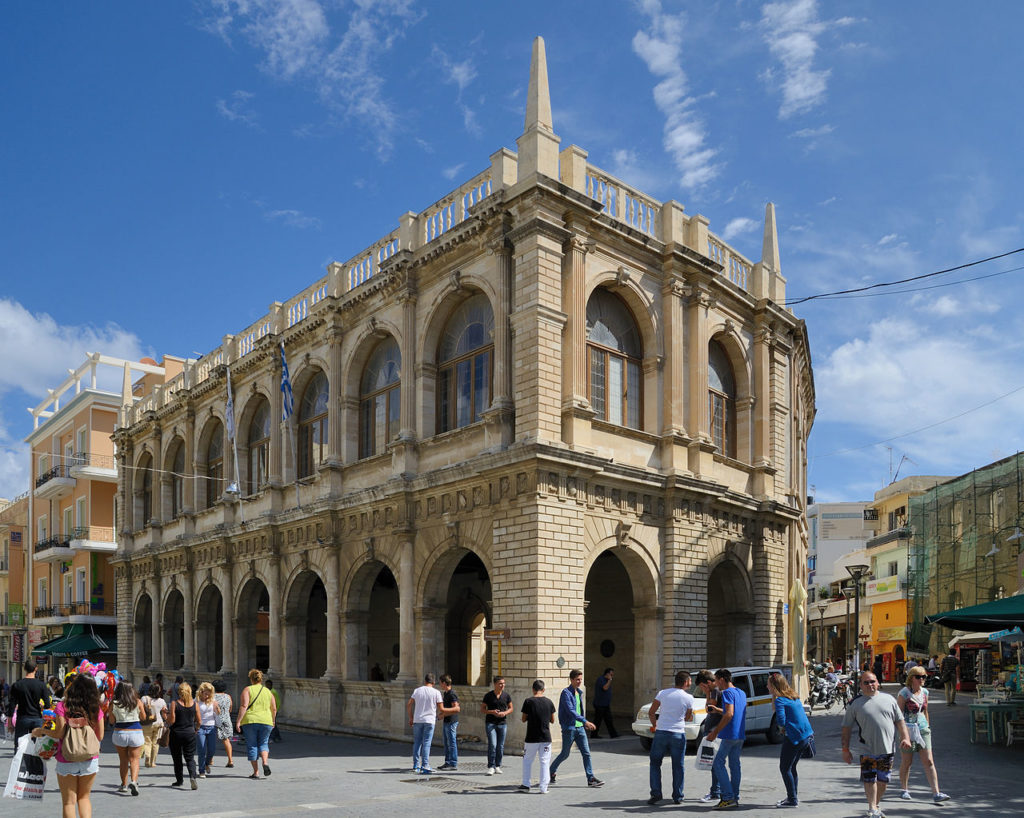
Crete is the largest of the Greek islands in terms of both landmass and population. It was an important Island that was controlled by the Republic of Venice as early as 1204 CE. For centuries, the Venetians would have a strong influence on Crete, and many important works of Venetian Architecture can be found in Crete’s two major cities. Heraklion is the larger of the two, and it is known for its massive Venetian Fortified Wall. The Venetian Loggia (depicted above) dates from 1626 and is one of the most well-known Venetian Buildings on the entire island.
4. Chania, Crete, Greece

Chania is the second-largest city on the island of Crete, and it is known for its Venetian Port (depicted above). Chania has one of the largest harbors in all of Greece, and it helped the Venetians Control a lot of the trade in the eastern portion of the Mediterranean. Much like Heraklion, Chania is completely surrounded by a fortified wall that separates the city from the mainland of Crete. This wall was built after the age of gunpowder, and it features short earth-packed stone walls that were good for absorbing cannon fire.
5. Nafpaktos, Western Greece, Greece
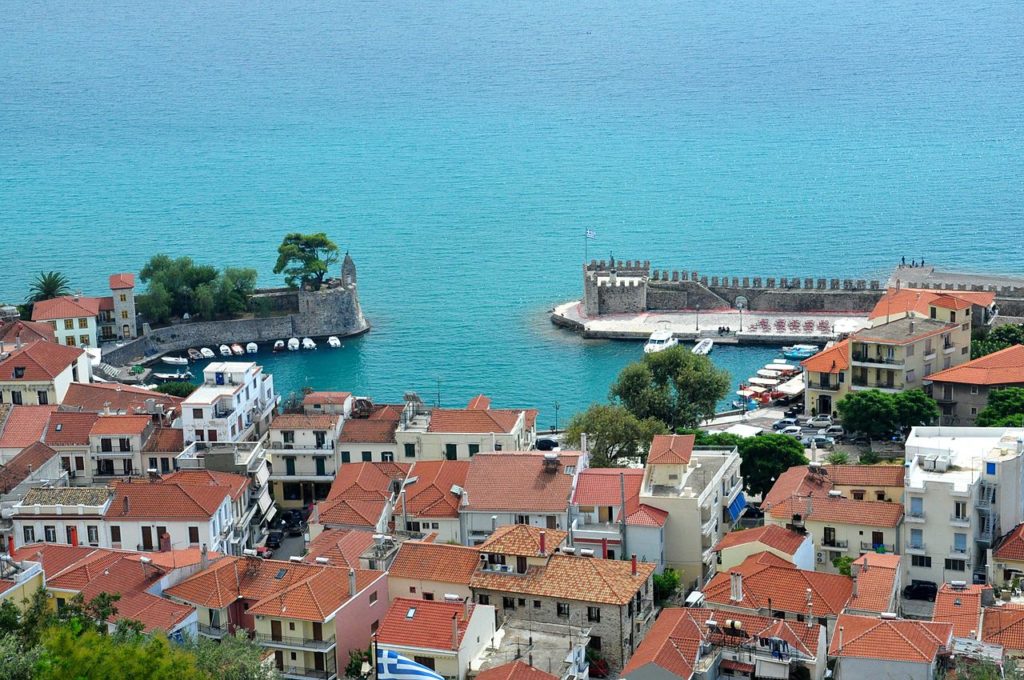
Nafpaktos is a former Venetian City located within the mainland of modern-day Greece. The most iconic element of the city is the Venetian Era port. The perimeter of the harbor is protected by stone walls with two towers at the entrance. The city was controlled by the Republic of Venice starting in 1407, but Venetian Control was short-lived and lasted less than 100 years. In 1499 Nafpaktos was taken by the forces of the Ottoman Empire and it would pass between the Venetians and the Ottomans more than once before finally being incorporated into the independent nation of Greece in 1829.
Venetian Architecture in Slovenia
All of the Venetian Cities within modern-day Slovenia are limited to the nation’s 29-mile (47 km) stretch of Adriatic Coastline. The cities located within this stretch of land all contain traces of Venetian culture. Like the cities of the Istrian Peninsula, the Venetian Cities of Slovenia share many distinct characteristics. Venetian-style Bell Towers, fortifications, and harbors are all important elements found throughout the region.
1. Piran, Istria, Slovenia
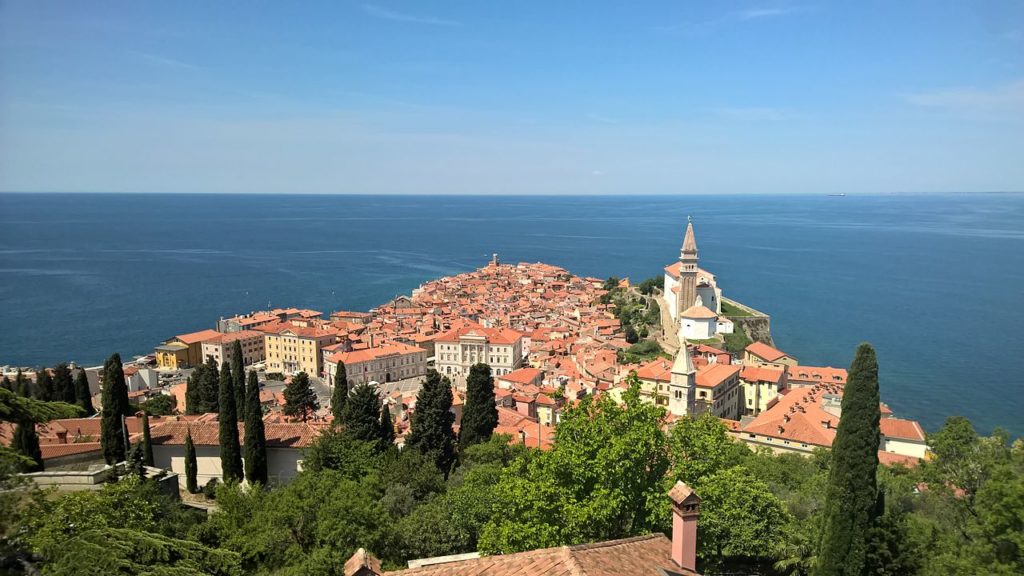
Piran is a former Venetian City located on Slovenia’s Adriatic Coastline. The city skyline is dominated by the Venetian Style Belltower that dates from the Renaissance Period. The bell tower is part of the Church of St. George, which sits on the highest point within the city center. Like many other cities in the region, Piran sits on an isolated peninsula that is surrounded by water on three sides. The Venetians enclosed the city with a fortified wall, which survives to this day.
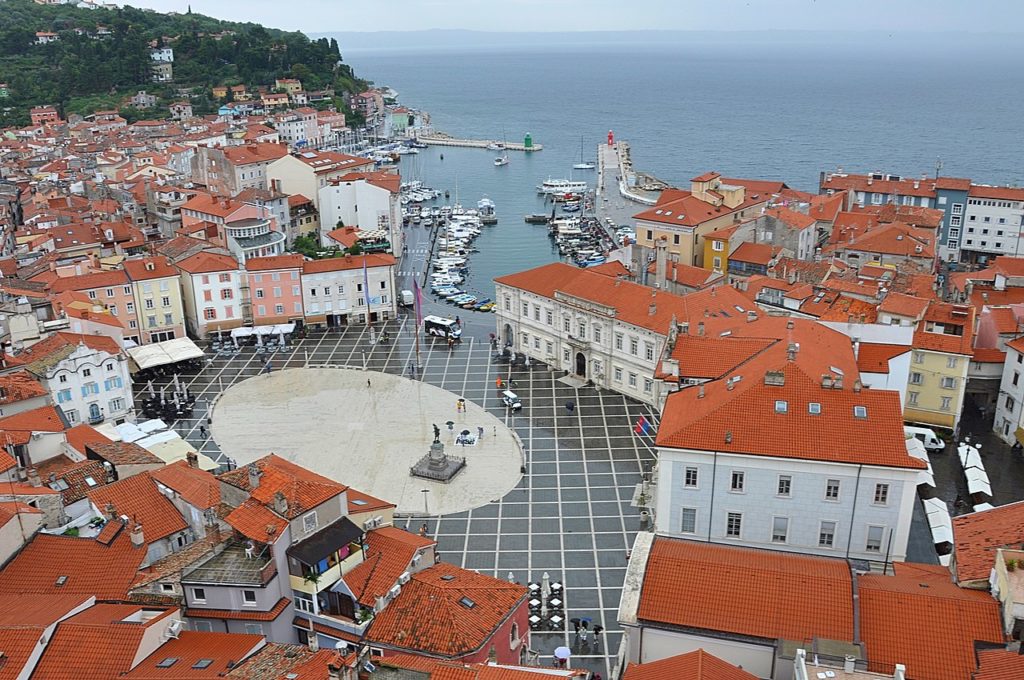
Piran became part of the Republic of Venice in 1283, and it remained a Venetian City until much of the republic was absorbed into the territories of Napoleon. The main harbor of Piran was once located where Tartini Square (depicted above) is located today. The harbor was the commercial hub of the city, and many important works of architecture surrounded it. However, in the late 19th century, decades of pollution had left the port of Piran a sewage-filled pit of murky water. City officials decided to fill in the harbor in 1894, creating a distinct elliptical square within the center of the city.
2. Koper, Istria, Slovenia

Located just 11 miles (19 km) to the east of Piran, Koper is another city in Slovenia that was once part of the Republic of Venice. Koper is one of the largest cities on the coast of Slovenia, and it features many great works of Venetian Architecture. The city’s main square contains several buildings that span many of Europe’s great architectural ages. The Cathedral of the Assumption is the city’s oldest church, and it originally dates from the Romanesque Age, although the Venetians made many modifications in the Renaissance and Baroque Styles.
Venetian Architecture in Montenegro
Located on the eastern coast of the Adriatic Sea, Montenegro is a small nation south of Croatia that formed after the breakup of Yugoslavia in the 20th century. Like Slovenia, Montenegro only contains a small coastline of just 183 miles (295 km). But within this area, there are several important cities that were once part of the Republic of Venice. Montenegro today is a proud and independent nation, but it owes much of its current architectural marvels to its time as an important region within Venice’s Adriatic Territories.
1. Kotor, Bay of Kotor, Montenegro
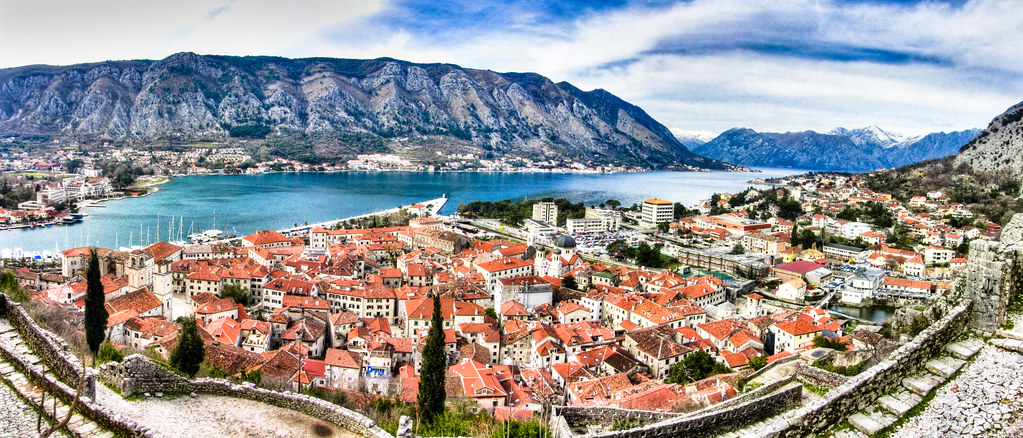
Kotor is a city located within the Bay of Kotor, a large body of water that is connected to the Adriatic Sea by a narrow strait. The Bay of Kotor was one of the earliest areas to be inscribed as a UNESCO World Heritage Site in 1979, and today the cities of Kotor, Perast, Risan, and Tivat are all towns that lie along the shores of this historic bay. Today, the Bay of Kotor is one of Montenegro’s most popular tourist destinations, and it’s a popular stop for cruise ships as they travel through the Adriatic.
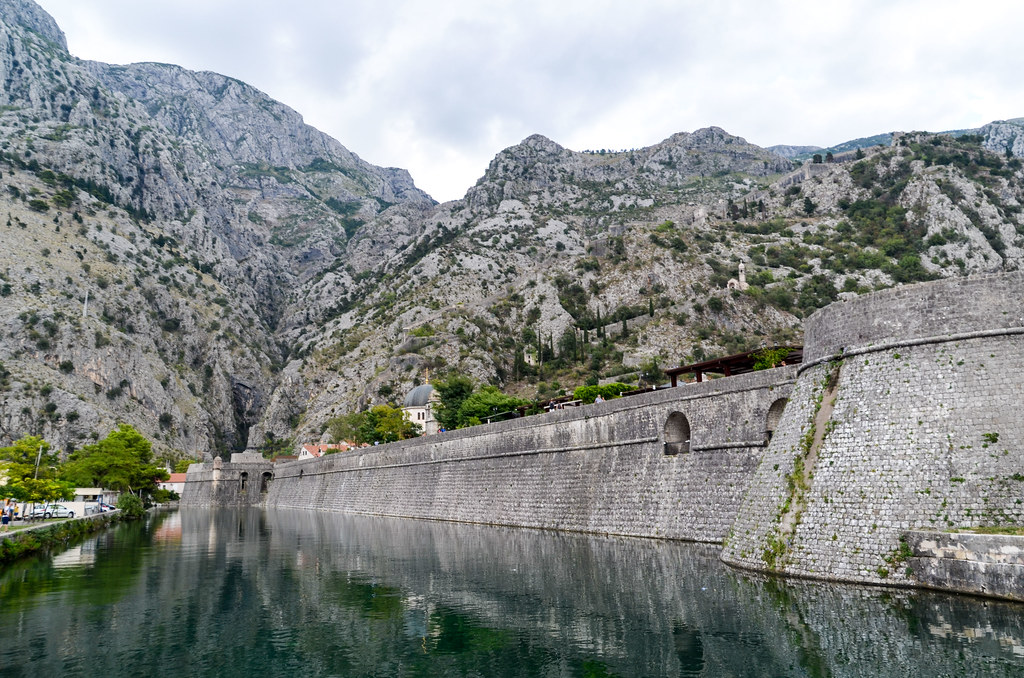
The city of Kotor is dominated by its massive fortification network. Located above the city’s historic center is a large medieval castle that has been in a state of neglect ever since gunpowder made the medieval castle obsolete in the 16th century. The Venetians constructed a thick stone wall that protected Kotor on its northern, southern, and western sides. These walls are several feet thick and are a great example of how the Republic of Venice was working hard to make sure its maritime empire remained strong and unchallenged.
2. Budva, Budva Municipality, Montenegro
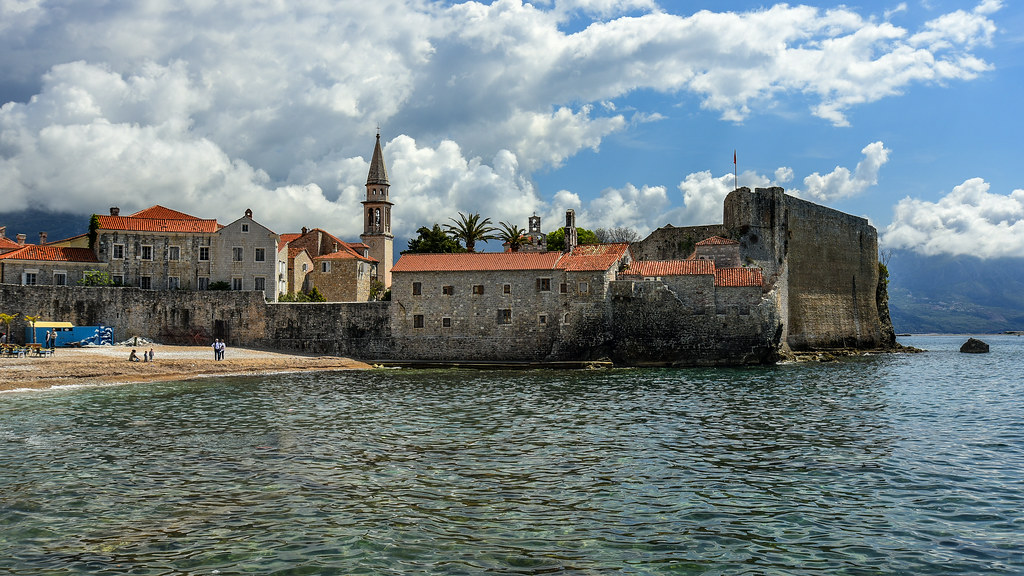
Budva is a city located along Montenegro’s western shores, but unlike Kotor, it’s fully exposed to the open sea and not protected by the Bay of Kotor. Budva became part of the Republic of Venice in the year 1420, and it remained part of Venice until after the breakup of the republic in 1797. Although much smaller than many other Venetian Cities in the region, such as Split and Corfu, Budva was still an important port town, and it contains many great examples of Venetian Architecture.
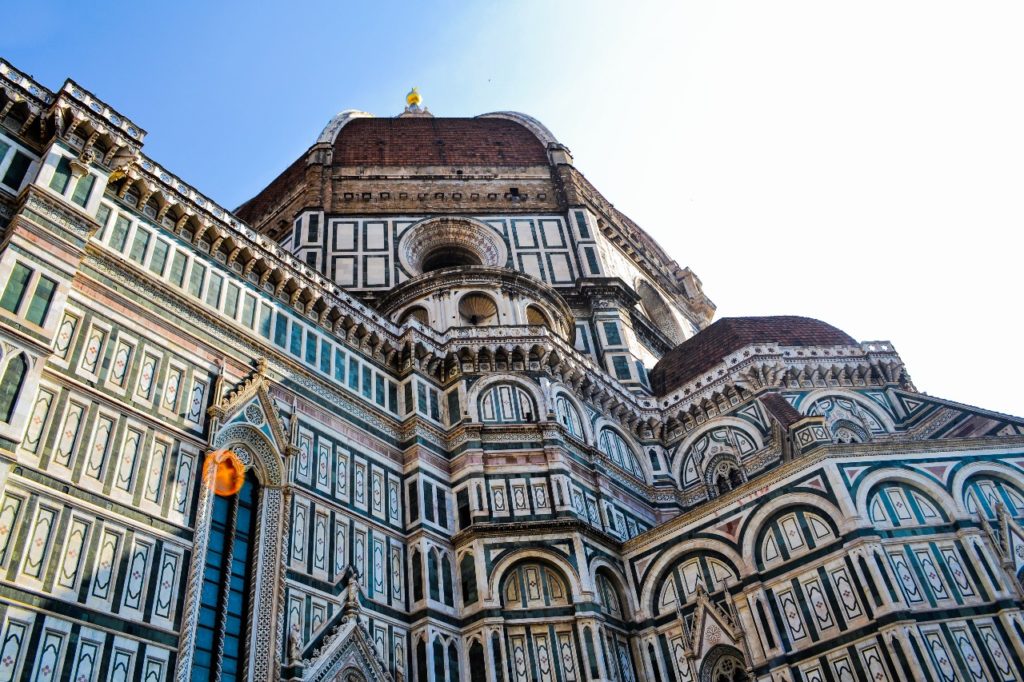
Interested in the architecture of Italy? Read our article, “Architecture of Florence, Tuscany, Italy” to learn more!
Venetian Architecture in Cyprus
Cyprus is the third-largest island in the Mediterranean, and its strategic location has made it an important outpost for many great nations such as the Ancient Greeks and Romans, the Byzantine Empire, and the Ottoman Empire. The Venetian Republic assumed control of the Island of Cyprus in 1473. Venice controlled Cyprus for nearly 100 years until it was lost in 1570 after a massive Ottoman invasion. The Ottomans went on to control the island for centuries, which led to a distinctive blend of Islamic and Christian Cultures throughout Cyprus.
1. Nicosia, Nicosia District, Cyprus
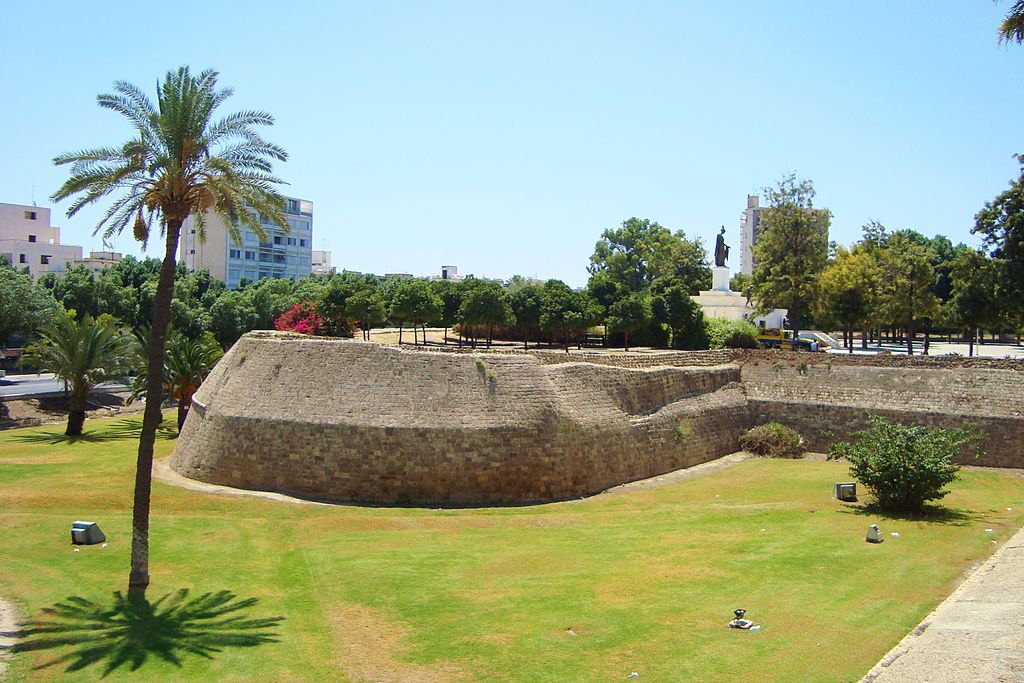
Nicosia is the capital of Cyprus, and the city center is completely surrounded by a series of fortified walls. These walls are designed in the typical Venetian Style from the 16th century, and they create a “star pattern” that allowed the city’s defenders to fire on the enemy from different angles. Today, Nicosia is at the heart of a political battle in Cyprus between the de facto state of the Turkish Republic of Northern Cyprus and the government of the Republic of Cyprus. Despite these political tensions, the city is an important hotspot for Venetian, Ottoman, and Crusader Architecture.
2. Famagusta, Famagusta District, Cyprus

Famagusta is another city on the eastern coast of Cyprus that was ruled by the Republic of Venice from 1489-1570. The city is known for its two large medieval cathedrals, which were later converted into mosques. These Mosque-Church crossovers can be found throughout the Middle East, in places that switched hands between Christian and Islamic control. The most iconic work of Venetian Architecture within Famagusta is the Palazzo del Provveditore (depicted above). The three main arches were once the main gateway to the palazzo, and they showcase many Renaissance-Style building elements such as the classical columns and the round arches.
Venetian Walls, Castles, and Fortifications
Although there are countless elements in Venetian Architecture that can be found throughout all of the cities mentioned above, one feature that unifies just about all of these places is a Venetian-style Fortification Network. The Venetians were constantly at war with powerful neighbors such as the Ottoman Turks. To help maintain control of their vast overseas domain, they invested huge amount of resources to build castles, forts, and walls throughout Venetian Lands.
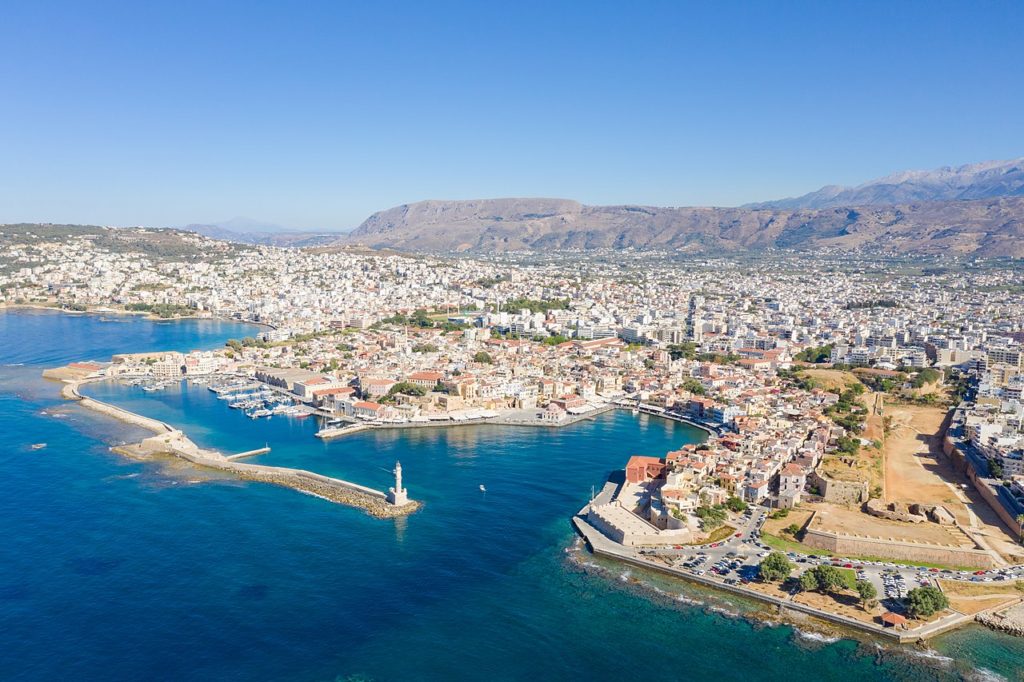
Chania in Greece has one of the best-preserved fortification networks, and you can clearly see the Venetian Fortified Wall on the right side of the image above. This wall network was designed with large triangular bastions that were notoriously difficult for armies to assault. The multi-sided walls were short and stout and often packed with earth as a way to absorb cannon fire. These walls were a major technological achievement, and the design was utilized throughout Europe, the Mediterranean, and can even be seen in military architecture in North and South America.
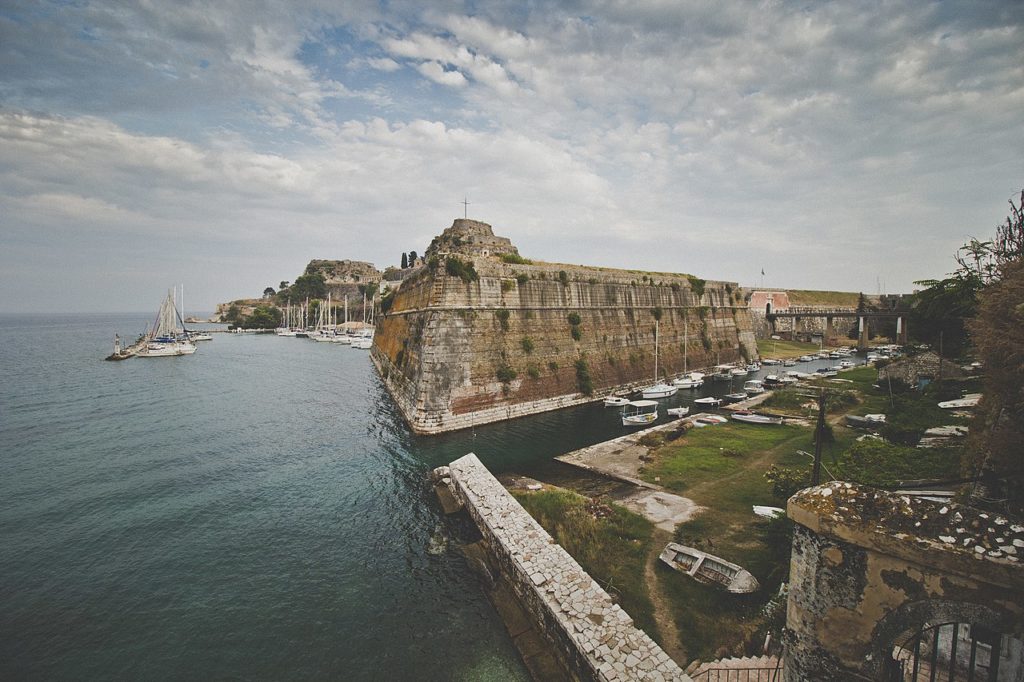
In cities like Chania and Heraklion, the Venetians enclosed the entire city within a ring of defensive walls. On the Island of Corfu, the Venetians went with a different strategy. There are two massive forts on either side of the Corfu City Center, and they are known as the Old and New Venetian Fortresses. Each of these forts contained its own supply of soldiers, cannons, and supplies such as gunpowder. In the event of a siege, an opposing army would need to subdue the forts before being able to take the city – which was no easy endeavor. Throughout their history, the Venetians and the Ottomans were constantly at war, as they were both competing to dominate the eastern Mediterranean trade networks, which had made Venice one of the wealthiest states of the Middle Ages.
Venetian Architecture in Review
All too often, we think of Venice as an isolated city within the Venetian Lagoon, but it’s important to remember that there are dozens of cities throughout Europe that were heavily influenced by Venetian Culture and Architecture. From Italy, to Croatia, Greece, Montenegro, Slovenia, and Cyprus, you can find different Venetian Cities that all share similar traits. The Republic of Venice wouldn’t last as a sovereign state, but the legacy of Venetian Architecture remains an important building style throughout the eastern Mediterranean and the Adriatic regions. Although Venice will always be the epicenter of Venetian Culture, the cities mentioned above also show how incredible the Venetians were and how the Republic of Venice left a lasting impact on the culture and architecture of the Mediterranean.

- About the Author
- Rob Carney, the founder and lead writer for Architecture of Cities has been studying the history of architecture for over 15 years.
- He is an avid traveler and photographer, and he is passionate about buildings and building history.
- Rob has a B.S. and a Master’s degree in Architecture and has worked as an architect and engineer in the Boston area for 10 years.
Like Architecture of Cities? Sign up for our mailing list to get updates on our latest articles and other information related to Architectural History.

